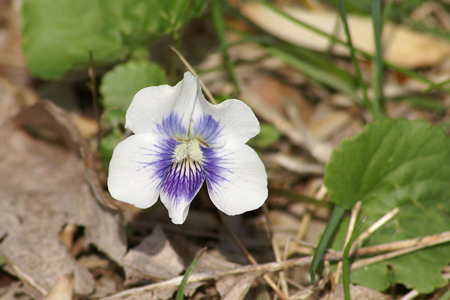Viola communis Pollard f. priceana (Pollard) H.E.Ballard
Common names:
Confederate Violet
Synonyms:
Viola communis Pollard f. priceana (Pollard) H.E.Ballard, comb. nov. Viola sororia Willd. f. priceana (Pollard) T. S. Cooperr., Mich. Bot. 23(4): 167. 1984; Viola papilionacea Pursh var. priceana (Pollard) Alexander, in Gleason, New Ill. fl. n. U.S. 2: 555. 1952; Viola priceana Pollard, Proc. Biol. Soc. Washington 16: 127. 1903. TYPE: USA, Kentucky, Bowling Green, In Lawns, 4 Jun 1900, S. F. Price s.n. (LECTOTYPE (designated here): US03013737 (n.v.); ISOLECTOTYPES: US03013734 (n.v.), US03013735 (n.v.), US03013736 (n.v.); internet images!).
Description:
Same as the species (see V. communis), but corolla white or very pale violet with dense coalescing nectarguide-lines forming a conspicuously contrasting broad blue, blue-gray or purple eyespot around the throat.
Ecology:
Same as the species.
Distribution:
Same as the species.
Rarity:
None.
Phenology:
Same as the species.
Hybrids:
Hybridizes with f. communis (Harvey Ballard, pers. comm.).
Comments:
In his protologue, Pollard wrote "In rich soil, various stations around Bowling Green, Kentucky. The description is drawn from a clump of plants in my garden, sent to me in May, 1901, by Miss Sadie F. Price; these flowered rather sparsely in April, 1902, but more freely in 1903, and were conspicuous when in bloom on account of the contrast between the purple margins and pale ground color of the corolla. Miss Price reported it as very constant in its characters, and as easily distinguishable from other violets with which it grew. A herbarium specimen taken from these living plants and deposited in the United States National Herbarium, is the type." An in-person search of collections at US and of the herbarium specimen database yielded no specimens collected by Pollard. However, five specimens from Miss Prices were found: one collected in 1899 by Miss Price (USA, Kentucky, Bowling Green, yards, 1 Apr 1899, US03012900) and four duplicates collected in 1900 by her (USA, Kentucky, Bowling Green, In Lawns, 4 Jun 1900, S. F. Price s.n. (US03013734, US03013735, US03013736, and US03013737). These presumably constitute original material. Since Pollard's type has not been found, a lectotype is designated here.
Henry (1953a) accepted this as a distinct species closely related to V. communis or V. sororia [glabrous variant] (which he collectively called V. papilionacea). Brainerd Baird (1942) and Alexander (1963) accepted the present taxon as V. papilionacea var. priceana; and Ballard (2013) treated it as V. sororia f. priceana. Brainerd (1921b) did not distinguish it from V. papilionacea; while Russell (1965), Ballard (2000), Voss and Reznicek (2012), and Weakley et al. (2012) implicitly or explicitly included it in V. sororia, and McKinney (1992) and McKinney and Russell (2002) synonymized it under V. sororia var. sororia. Fernald (1950) and Strausbaugh and Core (1978) inaccurately treated it as a synonym of V. papilionacea f. albiflora, ignoring that the latter is a true albino lacking nectarguide-lines while the former is a "partial" albino retaining the pigmentation of the nectarguide-lines. The new combination at the rank of forma is made here for the partial albino, placing it under the species with which it belongs morphologically and ecologically. The "Confederate Violet" and garden varieties developed from it are cultivated due to its attractive corolla color pattern and often escape locally, but ostensibly wild populations often grow quite remote from human habitation. The corollas in f. priceana tend to be larger than those of f. V. communis.
Literature Cited:
Alexander, E. J. 1963. Violaceae. In Gleason, H. A., The new Britton and Brown illustrated flora of the northeastern United States and adjacent Canada. Hafner Publishing Co., Inc., New York, NY. 552-567.Ballard Jr., H. E. 2000. Violaceae. In Rhoads, A. (ed.). Flora of Pennsylvania. University of Pennsylvania Press, Philadelphia, PA. 700-710.
Ballard Jr., H. E. 2013. Violaceae. In Yatskievych, G., Flora of Missouri. Missouri Botanical Garden Press, St. Louis, MO. 1218-1243.
Brainerd, E. 1921b. Violets of North America. Vermont Agricultural Experiment Station Bulletin 224: 1–172.
Brainerd Baird, V. 1942. Wild violets of North America. University of California Press, Berkeley, CA.
Cooperrider, T. S. 1984. Some species mergers and new combinations in the Ohio flora. Michigan Botanist 23(4): 165-168.
Fernald, M. L. 1950. Violaceae. Gray’s Manual of Botany, 8th ed. American Book Company, New York, NY. 1022-1042.
Gleason, H. A., and A. Cronquist. 1991. Violaceae. In Manual of vascular plants of northeastern United States and adjacent Canada, 2nd ed. New York Botanical Garden, Bronx, NY. 157-163.
Henry, L. K. 1953a. The Violaceae in western Pennsylvania. Castanea 18(2): 37-59.
Little, R. J., and L. E. McKinney. 2015. Violaceae. In Flora of North America: Cucurbitaceae to Droseraceae, 106. Oxford University Press, New York, NY.
McKinney, L. E. 1992. A taxonomic revision of the acaulescent blue violets (Viola) of North America. Sida, Botanical Miscellany 7: 1–60.
Russell, N. H. 1965. Violets (Viola) of the central and eastern United States: An introductory survey. Sida 2: 1–113.
Strausbaugh, P. D., and E. L. Core. 1978. Violaceae. In Flora of West Virginia, 2nd ed. Seneca Books, Inc., Morgantown, WV. 644-658.
Swink, F., and G. Wilhelm. 1979. Violaceae. In Plants of the Chicago region, 2nd ed. revised and expanded. Morton Arboretum, Lisle, IL. 384, 801-810.
Voss, E. G., and A. A. Reznicek. 2012. Violaceae. In Field manual of Michigan flora. The University of Michigan Press, Ann Arbor, MI. 913-922.
Weakley, A. S., J. C. Ludwig, and J. F. Townsend. 2012. Violaceae. In Flora of Virginia. BRIT Press, Fort Worth, TX. 963-975.

Chasmogamous flowering habit by Rob Broekhuis, robsplants.com

Chasmogamous flower front view by Ivy Main, Wikimedia Commons, under Creative Commons Licence SA 3.0